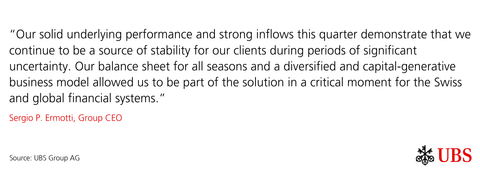UBS: 1Q23 net profit of USD 1.0bn, with strong client inflows (Ad hoc announcement pursuant to Article 53 of the SIX Exchange Regulation Listing Rules)

Sergio P. Ermotti Quote (Graphic:
UBS’s 1Q23 results materials are available at ubs.com/investors – The audio webcast of the earnings call starts at
A definition of each alternative performance measure, the method used to calculate it and the information content are presented under “Alternative performance measures” in the appendix to our 1Q23 report.
The reconciliation of reported and underlying performance is presented in the appendix of our 1Q23 results presentation.
Information in this news release is presented for
Group highlights
-
Solid underlying results and strong liquidity and capital amid uncertain market conditions
On a reported basis, and including an increase in provisions ofUSD 665m related to the US residential mortgage-backed securities (RMBS) litigation matter, 1Q23 PBT wasUSD 1,495m (-45% YoY). Net credit loss expenses wereUSD 38m , compared with net expenses ofUSD 18m in 1Q22. Total revenues decreased7% YoY, while operating expenses increased9% , driven by the aforementioned provision. The cost/income ratio was82.5% . Net profit attributable to shareholders wasUSD 1,029m (-52% YoY), with diluted earnings per share ofUSD 0.32 . The return on CET1 capital was9.1% .
On an underlying basis, 1Q23 PBT wasUSD 2,354m , (-22% YoY). Underlying revenues decreased8% YoY, while operating expenses decreased2% , or1% when excluding FX. The cost/income ratio was72.8% and the return on CET1 capital was16.5% .
In the quarter, we repurchasedUSD 1.3bn of shares under our share repurchase program. We have temporarily suspended share repurchases following the announcement of the anticipated acquisition of Credit Suisse, and we intend to resume them as soon as possible.
Our capital position remained strong. The quarter-end CET1 capital ratio was13.9% and the CET1 leverage ratio was4.40% , both in excess of our guidance of ~13% and >3.7% , respectively. We also maintained healthy liquidity buffers with an LCR of162% and an NSFR of118% .
-
Continued client momentum with inflows in all regions
In the first quarter, we maintained positive momentum across the firm and attractedUSD 28bn of net new money in GWM, of whichUSD 7bn came in the last ten days of March, after the announcement of our acquisition of Credit Suisse. We also sawUSD 20bn in net new fee-generating assets1 in GWM,USD 14bn of net new money in AM (of whichUSD 18bn in money market), andCHF 0.9bn of net new investment products for Personal Banking. Overall, we saw broadly stable loan balances2 as loan growth inSwitzerland offset deleveraging in other regions. As clients repositioned their investments in response to interest rate increases, we captured demand for higher yield into money market funds and US-government securities.
We delivered these results during a quarter characterized by persistent concerns about interest rates and economic growth exacerbated by questions about the stability of the banking system, especially in the US. Against this backdrop, private and institutional investors' activity remained muted.
InAmericas , GWM attracted net new fee-generating assets1 ofUSD 4bn , with continued positive momentum in our SMA3 offering, which contributedUSD 4.5bn of net new money in AM. In the quarter we also sawUSD 8bn net new money in GWM, and continued momentum in advisor recruiting.
InSwitzerland , we sawUSD 8bn net new fee-generating assets,1USD 2bn net new loans in GWM and P&C combined andUSD 0.9bn net new investment products for Personal Banking (16% annualized growth).
In EMEA, we generatedUSD 3bn of net new fee-generating assets1 and net interest income rose by nearly60% as we started to benefit from higher euro rates. We were also named best equities bank in EMEA4 andEurope financial bond house for the year.5
In APAC, we attractedUSD 5bn of net new fee-generating assets1 contributing to a17% net new fee-generating asset growth over the past 12 months, and we were recently named the best equity house inAsia and ANZ6 and best M&A bank in APAC by Global Finance.
1 In GWM; net new fee-generating assets exclude the effects on fee-generating assets of strategic decisions by |
-
Enhancing client franchises through the announced acquisition of Credit Suisse
We expect the combination with Credit Suisse to strengthen our position as a leading and truly global wealth manager, with aroundUSD 5trn in invested assets. We also expect to reinforce our position as a leading universal bank inSwitzerland , and to enhance our complementary investment banking and asset management capabilities, while adding strategic scale in the most attractive growth markets.
We intend to actively reduce the risk and resource consumption of Credit Suisse’s investment banking business. We plan for the combinedInvestment Bank (excluding assets and liabilities that we define as non-core) to account for around25% of Group RWAs and to remain focused and strategically aligned to the products and capabilities that are most relevant to our wealth management clients.
While acknowledging the magnitude of, and complexity associated with, the integration and restructuring of Credit Suisse, we believe that this combination presents a unique opportunity to bring significant, long-term value to all of our stakeholders.
“During the first quarter we saw strong net new fee generating asset and net new money inflows in Global Wealth Management and Asset Management. This was possible thanks to the disciplined execution and dedication of all our employees. We helped clients navigate a challenging environment marked by the ongoing uncertainty around inflation, central bank policy, and economic growth. Our results also included an increase in litigation provisions relating to RMBS. We are in advanced discussions with the
With the planned acquisition of Credit Suisse, we are taking another transformational step in UBS’s journey, while remaining committed to our culture, strategy and disciplined risk management. With this transaction, we expect to reinforce our position as a leading and truly global wealth manager with strategic scale and complementary capabilities in the most attractive growth markets.
I am convinced that this transaction will help to reinforce the leading position of the Swiss financial center and will be of benefit to the entire economy. The combined firm presents a unique opportunity to generate significant, long-term value to all of our stakeholders.”
Outlook
Persistently high inflation and tight labor markets in many countries in the first quarter of 2023 caused central banks to continue to raise interest rates. The recent liquidity concerns in the banking sector and geopolitical tensions, particularly between the US and
The macroeconomic situation going forward remains uncertain, and while concerns about the stability of banks have abated, they have not gone away. As a result, client activity levels could remain subdued in the second quarter of 2023. Weak client sentiment may affect net new assets in our asset-gathering businesses; however, we expect net interest income will remain at higher levels, compared with last year, in the current interest rate environment.
We are focused on completing the acquisition of Credit Suisse, most likely in the second quarter of 2023 which will advance our strategy, particularly in Global Wealth Management and
First quarter 2023 performance overview – Group
Group |
1Q23 |
|
Targets/guidance |
|
Return on CET1 capital |
|
|
15– |
|
Return on tangible equity |
|
|
|
|
Cost/income ratio |
|
|
70– |
|
Net profit attributable to shareholders |
|
|
|
|
CET1 capital ratio |
|
|
~ |
|
CET1 leverage ratio |
|
|
> |
|
Tangible book value per share |
|
|
|
|
Buybacks |
|
|
Temporarily suspended |
Group PBT
PBT was
First quarter 2023 performance overview – Business Divisions and Group Functions
Global Wealth Management |
1Q23 |
|
Targets/guidance |
|
Profit before tax |
|
|
|
|
PBT growth |
- |
|
10– |
|
Invested assets |
|
|
|
|
Net new fee-generating assets1 |
|
|
|
|
|
|
|
|
|
Personal & Corporate Banking |
|
|
|
|
Profit before tax |
|
|
|
|
Return on attributed equity (CHF) |
|
|
|
|
Net new investment products for Personal Banking |
|
|
|
|
|
|
|
|
|
Asset Management |
|
|
|
|
Profit before tax |
|
|
|
|
Invested assets |
|
|
|
|
Net new money excl. money markets |
|
|
|
|
|
|
|
|
|
|
|
|
|
|
Profit before tax |
|
|
|
|
Return on attributed equity |
|
|
|
|
RWA and LRD vs. Group |
|
|
Up to 1/3 |
Global Wealth Management (GWM)
PBT
Total revenues decreased
1 Net new fee-generating assets exclude the effects on fee-generating assets of strategic decisions by |
Personal & Corporate Banking (P&C)
PBT
Total revenues increased
Asset Management (AM) PBT
Total revenues were down
1 2Q22 included an |
Total revenues decreased
Group Functions PBT
Extending UBS’s leadership in sustainability
Sustainable finance is crucial when it comes to helping our clients achieve their diverse sustainability objectives. We want to be the provider of choice for clients who wish to mobilize capital toward the achievement of the
Shareholders support UBS’s sustainability approach
At the recent Annual General Meeting, shareholders ratified the UBS Sustainability Report in an advisory vote by
In the first quarter, we were once again recognized by CDP as a Supplier Engagement Leader for our work engaging with our suppliers to tackle climate change.
Diversity, equity and inclusion are key to sustainability
In April, we published our first global Diversity, Equity and Inclusion Report, detailing our DE&I areas of focus, our strategic goals and our approach to achieving them.
According to the Global Gender Equality Report 2023 published by Equileap,
In the US, we recently announced our
Our key figures |
|
|
|
|
||
|
|
As of or for the quarter ended |
||||
USD m, except where indicated |
|
|
|
|
||
Group results |
|
|
|
|
||
Total revenues |
|
8,744 |
8,029 |
9,382 |
||
Credit loss expense / (release) |
|
38 |
7 |
18 |
||
Operating expenses |
|
7,210 |
6,085 |
6,634 |
||
Operating profit / (loss) before tax |
|
1,495 |
1,937 |
2,729 |
||
Net profit / (loss) attributable to shareholders |
|
1,029 |
1,653 |
2,136 |
||
Diluted earnings per share (USD)1 |
|
0.32 |
0.50 |
0.61 |
||
Profitability and growth2 |
|
|
|
|
||
Return on equity (%) |
|
7.2 |
11.7 |
14.3 |
||
Return on tangible equity (%) |
|
8.1 |
13.2 |
16.0 |
||
Return on common equity tier 1 capital (%) |
|
9.1 |
14.7 |
19.0 |
||
Return on leverage ratio denominator, gross (%) |
|
3.4 |
3.2 |
3.5 |
||
Cost / income ratio (%) |
|
82.5 |
75.8 |
70.7 |
||
Effective tax rate (%) |
|
30.7 |
14.5 |
21.4 |
||
Net profit growth (%) |
|
(51.8) |
22.6 |
17.1 |
||
Resources2 |
|
|
|
|
||
Total assets |
|
1,053,134 |
1,104,364 |
1,139,922 |
||
Equity attributable to shareholders |
|
56,754 |
56,876 |
58,855 |
||
Common equity tier 1 capital3 |
|
44,590 |
45,457 |
44,593 |
||
Risk-weighted assets3 |
|
321,660 |
319,585 |
312,037 |
||
Common equity tier 1 capital ratio (%)3 |
|
13.9 |
14.2 |
14.3 |
||
Going concern capital ratio (%)3 |
|
17.9 |
18.2 |
19.2 |
||
Total loss-absorbing capacity ratio (%)3 |
|
34.3 |
33.0 |
34.2 |
||
Leverage ratio denominator3 |
|
1,014,446 |
1,028,461 |
1,072,953 |
||
Common equity tier 1 leverage ratio (%)3 |
|
4.40 |
4.42 |
4.16 |
||
Liquidity coverage ratio (%)4 |
|
161.9 |
163.7 |
159.6 |
||
Net stable funding ratio (%) |
|
117.7 |
119.8 |
121.7 |
||
Other |
|
|
|
|
||
Invested assets (USD bn)5 |
|
4,160 |
3,957 |
4,380 |
||
Personnel (full-time equivalents) |
|
73,814 |
72,597 |
71,697 |
||
Market capitalization1 |
|
64,322 |
57,848 |
65,775 |
||
Total book value per share (USD)1 |
|
18.59 |
18.30 |
17.57 |
||
Tangible book value per share (USD)1 |
|
16.54 |
16.28 |
15.67 |
||
1 Refer to the “Share information and earnings per share” section of the |
||||||
Income statement |
|
|
|
|
|
|
|
|||
|
|
For the quarter ended |
|
% change from |
||||||
USD m |
|
|
|
|
|
4Q22 |
1Q22 |
|||
Net interest income |
|
1,388 |
1,589 |
1,771 |
|
(13) |
(22) |
|||
Other net income from financial instruments measured at fair value through profit or loss |
|
2,681 |
1,876 |
2,226 |
|
43 |
20 |
|||
Net fee and commission income |
|
4,606 |
4,359 |
5,353 |
|
6 |
(14) |
|||
Other income |
|
69 |
206 |
32 |
|
(66) |
119 |
|||
Total revenues |
|
8,744 |
8,029 |
9,382 |
|
9 |
(7) |
|||
|
|
|
|
|
|
|
|
|||
Credit loss expense / (release) |
|
38 |
7 |
18 |
|
430 |
108 |
|||
|
|
|
|
|
|
|
|
|||
Personnel expenses |
|
4,620 |
4,122 |
4,920 |
|
12 |
(6) |
|||
General and administrative expenses |
|
2,065 |
1,420 |
1,208 |
|
45 |
71 |
|||
Depreciation, amortization and impairment of non-financial assets |
|
525 |
543 |
506 |
|
(3) |
4 |
|||
Operating expenses |
|
7,210 |
6,085 |
6,634 |
|
18 |
9 |
|||
Operating profit / (loss) before tax |
|
1,495 |
1,937 |
2,729 |
|
(23) |
(45) |
|||
Tax expense / (benefit) |
|
459 |
280 |
585 |
|
64 |
(22) |
|||
Net profit / (loss) |
|
1,037 |
1,657 |
2,144 |
|
(37) |
(52) |
|||
Net profit / (loss) attributable to non-controlling interests |
|
8 |
4 |
8 |
|
116 |
1 |
|||
Net profit / (loss) attributable to shareholders |
|
1,029 |
1,653 |
2,136 |
|
(38) |
(52) |
|||
|
|
|
|
|
|
|
|
|||
Comprehensive income |
|
|
|
|
|
|
|
|||
Total comprehensive income |
|
1,833 |
2,208 |
(72) |
|
(17) |
|
|||
Total comprehensive income attributable to non-controlling interests |
|
13 |
17 |
26 |
|
(24) |
(50) |
|||
Total comprehensive income attributable to shareholders |
|
1,820 |
2,190 |
(98) |
|
(17) |
|
|||
Comparison between |
|
|
|
|
||||||||
|
|
As of or for the quarter ended |
|
As of or for the quarter ended |
||||||||
USD m, except where indicated |
|
|
|
Difference
|
|
|
|
Difference
|
||||
|
|
|
|
|
|
|
|
|
||||
Income statement |
|
|
|
|
|
|
|
|
||||
Total revenues |
|
8,744 |
8,844 |
(101) |
|
8,029 |
8,078 |
(49) |
||||
Credit loss expense / (release) |
|
38 |
38 |
0 |
|
7 |
7 |
0 |
||||
Operating expenses |
|
7,210 |
7,350 |
(140) |
|
6,085 |
6,282 |
(198) |
||||
Operating profit / (loss) before tax |
|
1,495 |
1,456 |
39 |
|
1,937 |
1,788 |
148 |
||||
of which: Global Wealth Management |
|
1,215 |
1,199 |
17 |
|
1,058 |
1,047 |
11 |
||||
of which: Personal & Corporate Banking |
|
599 |
597 |
2 |
|
529 |
525 |
4 |
||||
of which: Asset Management |
|
94 |
94 |
0 |
|
124 |
122 |
2 |
||||
of which: |
|
477 |
455 |
21 |
|
112 |
108 |
4 |
||||
of which: Group Functions |
|
(890) |
(889) |
(1) |
|
114 |
(13) |
127 |
||||
Net profit / (loss) |
|
1,037 |
1,012 |
25 |
|
1,657 |
1,522 |
135 |
||||
of which: net profit / (loss) attributable to shareholders |
|
1,029 |
1,004 |
25 |
|
1,653 |
1,518 |
135 |
||||
of which: net profit / (loss) attributable to non-controlling interests |
|
8 |
8 |
0 |
|
4 |
4 |
0 |
||||
|
|
|
|
|
|
|
|
|
||||
Statement of comprehensive income |
|
|
|
|
|
|
|
|
||||
Other comprehensive income |
|
796 |
792 |
4 |
|
551 |
499 |
52 |
||||
of which: attributable to shareholders |
|
791 |
787 |
4 |
|
538 |
485 |
52 |
||||
of which: attributable to non-controlling interests |
|
5 |
5 |
0 |
|
13 |
13 |
0 |
||||
Total comprehensive income |
|
1,833 |
1,804 |
29 |
|
2,208 |
2,020 |
187 |
||||
of which: attributable to shareholders |
|
1,820 |
1,791 |
29 |
|
2,190 |
2,003 |
187 |
||||
of which: attributable to non-controlling interests |
|
13 |
13 |
0 |
|
17 |
17 |
0 |
||||
|
|
|
|
|
|
|
|
|
||||
Balance sheet |
|
|
|
|
|
|
|
|
||||
Total assets |
|
1,053,134 |
1,056,758 |
(3,625) |
|
1,104,364 |
1,105,436 |
(1,072) |
||||
Total liabilities |
|
996,028 |
998,021 |
(1,993) |
|
1,047,146 |
1,048,496 |
(1,349) |
||||
Total equity |
|
57,106 |
58,738 |
(1,632) |
|
57,218 |
56,940 |
278 |
||||
of which: equity attributable to shareholders |
|
56,754 |
58,386 |
(1,632) |
|
56,876 |
56,598 |
278 |
||||
of which: equity attributable to non-controlling interests |
|
352 |
352 |
0 |
|
342 |
342 |
0 |
||||
|
|
|
|
|
|
|
|
|
||||
Capital information |
|
|
|
|
|
|
|
|
||||
Common equity tier 1 capital |
|
44,590 |
42,801 |
1,789 |
|
45,457 |
42,929 |
2,528 |
||||
Going concern capital |
|
57,694 |
55,116 |
2,578 |
|
58,321 |
54,770 |
3,551 |
||||
Risk-weighted assets |
|
321,660 |
321,224 |
436 |
|
319,585 |
317,823 |
1,762 |
||||
Common equity tier 1 capital ratio (%) |
|
13.9 |
13.3 |
0.5 |
|
14.2 |
13.5 |
0.7 |
||||
Going concern capital ratio (%) |
|
17.9 |
17.2 |
0.8 |
|
18.2 |
17.2 |
1.0 |
||||
Total loss-absorbing capacity ratio (%) |
|
34.3 |
33.5 |
0.8 |
|
33.0 |
32.0 |
0.9 |
||||
Leverage ratio denominator |
|
1,014,446 |
1,018,023 |
(3,577) |
|
1,028,461 |
1,029,561 |
(1,100) |
||||
Common equity tier 1 leverage ratio (%) |
|
4.40 |
4.20 |
0.19 |
|
4.42 |
4.17 |
0.25 |
||||
|
|
|
|
|
||||||||
Information about results materials and the earnings call
UBS’s first quarter 2023 report, news release and slide presentation are available from
Time
03:00 US EDT
Audio webcast
The presentation for analysts can be followed live on ubs.com/quarterlyreporting with a simultaneous slide show.
Webcast playback
An audio playback of the results presentation will be made available at ubs.com/investors later in the day.
Cautionary Statement Regarding Forward-Looking Statements
This news release contains statements that constitute “forward-looking statements,” including but not limited to management’s outlook for UBS’s financial performance, statements relating to the anticipated effect of transactions and strategic initiatives on UBS’s business and future development and goals or intentions to achieve climate, sustainability and other social objectives. While these forward-looking statements represent UBS’s judgments, expectations and objectives concerning the matters described, a number of risks, uncertainties and other important factors could cause actual developments and results to differ materially from UBS’s expectations. The Russia–Ukraine war has led to heightened volatility across global markets, exacerbated global inflation, and slowed global growth. In addition, the war has caused significant population displacement, and if the conflict continues or escalates, the scale of disruption will increase and continue to cause shortages of vital commodities, including energy shortages and food insecurity, and may lead to recessions in
Rounding
Numbers presented throughout this news release may not add up precisely to the totals provided in the tables and text. Percentages and percent changes disclosed in text and tables are calculated on the basis of unrounded figures. Absolute changes between reporting periods disclosed in the text, which can be derived from numbers presented in related tables, are calculated on a rounded basis.
Tables
Within tables, blank fields generally indicate non-applicability or that presentation of any content would not be meaningful, or that information is not available as of the relevant date or for the relevant period. Zero values generally indicate that the respective figure is zero on an actual or rounded basis. Values that are zero on a rounded basis can be either negative or positive on an actual basis.
View source version on businesswire.com: https://www.businesswire.com/news/home/20230424005968/en/
Investor contact
Media contact
APAC: +852-297-1 82 00
ubs.com
Source:







